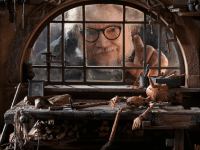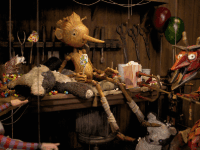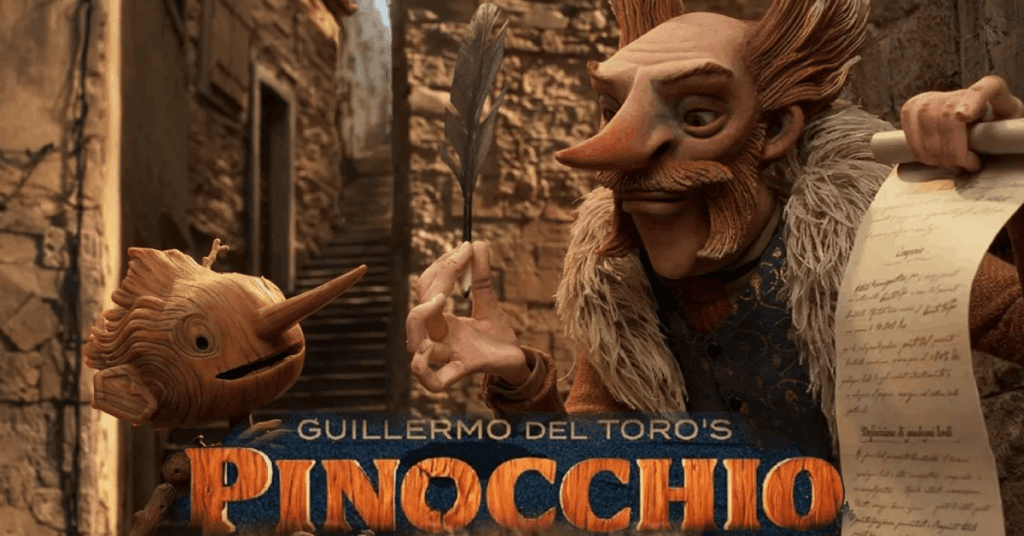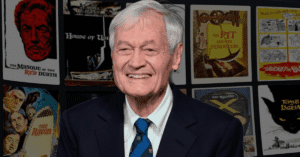The Beauty of Stop-Motion Animation
Stop-motion animation has been around for decades, starting with early filmmakers like Willis O’Brien (King Kong, 1933) and Ray Harryhausen (Jason and the Argonauts, 1963). This technique involves moving puppets frame by frame to create the illusion of life. Studios like LAIKA (Coraline, 2009; Kubo and the Two Strings, 2016) and Aardman (Wallace & Gromit: The Curse of the Were-Rabbit, 2005) have kept this beautiful art alive. But Pinocchio (2022) takes it to another level, combining artistry with deep storytelling.
Why Guillermo del Toro Chose Stop-Motion

Del Toro has always loved stop-motion animation. He said, “I wanted the expressiveness and the material nature of a handmade piece of animation, an artisanal, beautiful exercise in carving, painting, sculpting”. He felt that Pinocchio was a story about a wooden puppet, so using real handcrafted puppets would make it even more special.
He also wanted to embrace the imperfections of handmade art. Unlike digital animation, which can feel too polished, stop-motion allows for tiny irregularities that make the characters feel more real. Every scratch, brushstroke, and movement tells a story, adding to the film’s emotional depth.
The Unique Visual Style of Guillermo del Toro’s Pinocchio

The film looks like a magical wooden world. The puppets were carefully designed, with tiny details that made them feel real. The sets were also handmade, giving the film a warm and artistic feel. Del Toro worked with Mark Gustafson, an expert in stop-motion, to make sure every movement felt natural and emotional. The result is a film that feels alive in every frame.
The character designs in Pinocchio (2022) also stand out. Instead of the traditional friendly wooden boy, this Pinocchio looks rough, unfinished, and full of personality. This unique take adds to the film’s charm and reinforces its themes of individuality and self-acceptance.
Innovations in Stop-Motion Animation
Stop-motion can sometimes feel stiff, but in Pinocchio (2022), the characters move smoothly and naturally. The team used special techniques to make the animation look more fluid. They even added motion blur to make movements feel more real. These innovations helped make the film a ground-breaking achievement in stop-motion animation.
One major breakthrough was the use of 3D-printed facial expressions. This allowed for subtle emotions, making Pinocchio and other characters more expressive than traditional stop-motion figures. These techniques helped bridge the gap between handcrafted animation and modern technology, setting a new standard for stop-motion films.
A Deeper Story in Guillermo del Toro’s Pinocchio
Unlike other versions of Pinocchio, del Toro’s film tells a deeper story about love, loss, and being yourself. The film is set in Fascist Italy, giving it a darker and more meaningful background. Pinocchio is not just a mischievous child, he is someone trying to understand the world. Geppetto’s grief is also explored in a unique way. He does not instantly love Pinocchio but learns to care for him over time. This makes their relationship more touching and real. Stop-motion adds to this emotional depth, making every expression and movement feel full of life.
Death and imperfection are major themes in this version. Unlike Disney’s version, where Pinocchio strives to become a “real boy,” del Toro’s Pinocchio learns that being himself is enough. This powerful message resonates deeply, reminding audiences that identity and self-worth come from within.
Comparing Guillermo del Toro’s Pinocchio to Other Stop-Motion Animation Films
Many great stop-motion films have come before, like Coraline (2009), Fantastic Mr. Fox (2009), and Kubo and the Two Strings (2016). These films also used stop-motion to tell deep, emotional stories. But del Toro’s Pinocchio is different because it is not just about adventure, it is about the meaning of life and love. Unlike the dark fantasy of Coraline or the quirky humor of Fantastic Mr. Fox, Pinocchio blends realism with fantasy in a way that few films have done. The historical setting adds layers of meaning, making it a film that speaks to both children and adults on different levels.
The Impact of Guillermo del Toro’s Pinocchio on Stop-Motion Animation
With CGI and digital animation being so popular, stop-motion often gets overlooked. But del Toro’s Pinocchio (2022) proved that handcrafted animation is still powerful. The film won the Academy Award for Best Animated Feature, showing that stop-motion can still compete with big-budget animated films. Del Toro said, “Animation is not a genre; animation is a medium”. His love for stop-motion has inspired a new generation of animators to explore this beautiful art form. Additionally, the success of Pinocchio (2022) has encouraged more studios to invest in stop-motion projects. With streaming platforms looking for unique content, stop-motion films are getting more attention, ensuring the art form continues to evolve and thrive.
Guillermo del Toro’s Pinocchio (2022) is more than just an animated film, it is a celebration of creativity and storytelling. By using stop-motion, del Toro honored the beauty of handmade animation while pushing it to new heights. The film’s detailed puppetry, stunning visuals, and heartfelt story make it a milestone in animation history. Pinocchio (2022) is a reminder that true art comes from passion, patience, and a love for storytelling.
The film also proves that animation can tell mature, meaningful stories without losing its wonder. By blending history, emotion, and breathtaking craftsmanship, del Toro has created a film that will be remembered for generations. His dedication to stop-motion ensures that this timeless art form will continue to inspire filmmakers and audiences alike.



























25 Responses